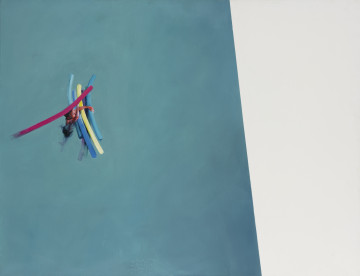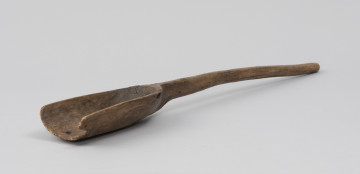
Grain basket
1900 — 1950
National Museum in Szczecin
Part of the collection: European classics of modernity
In 1945, Władysław Strzemiński became a lecturer at the State Higher School of Visual Arts (PWSSP) in Łódź, of which he was a co-founder. In the same year he donated his artistic legacy to the Museum of Art in Lodz, and in 1948, he designed the Neoplastic Room there. In 1950, he was dismissed from the State Higher School of Visual Arts on a charge of failing to adhere to the doctrine of socialist realism. Since then the painter struggled with financial problems. In 1951 he was diagnosed with advanced tuberculosis, which led to his death a year later. In the collection of the National Museum in Szczecin there is a painting entitled Kłosy [Ears] from 1950, i.e. from the final period of his career. However, in private collections, there is a similar painting with the same title from the same year. It shows forms typical of Strzemiński's pre-war work with clouds appeared as autonomous forms in his wrapping paper prints. In the background there is a two-coloured plane - intense yellow at the bottom, referring the viewer to fields, and ultramarine blue from above, connoting the sky. Against this background, the black outline of the ears stands out, considerably enlarged and divided into two colour zones - orange and light grey. On the edge and in the middle, on one side, they have patches of turquoise giving a shadow effect. Their simplification is a form of translating Strzemiński's theoretical considerations on the formation of the perception of art depending on the knowledge and awareness of the viewer. Strzemiński assumes that the viewer's perception of the presented reality or expectations depends on his knowledge, the number of works he has seen and the historical moment. In his forms we can find studies of primitive cultures, which we find, among other things, in Teoria widzenia [Theory of Vision]. Spikes are a motif popular in the interwar period, among others, later symbolising fertility and prosperity. In the context of works of the father of the Polish avant-garde, it must be an inseparable part of communist symbolism as in the case of the union republics of the USSR emblems. It is not without significance that the work was created when the artist knew that he was not welcome by the authorities at the university. It can be assumed that the use of a motif close to socialist realism was an attempt to convince the viewer to create under the doctrine seemingly. Similarly, critics read the formulation of theoretical texts, which are close to the guidelines of the communist system. However, these sketches and the Szczecin painting are only superficially in line with the top-down recommendations. For the ears - and the theory behind them - are a negation of the guidelines of realism. They are a form of questioning the validity of such attempts to represent reality.
Beata Małgorzata Wolska
Author / creator
Dimensions
cały obiekt: height: 25 cm, width: 35 cm
Object type
painting
Creation time / dating
Creation / finding place
Identification number
Location / status

1900 — 1950
National Museum in Szczecin

2010
National Museum in Szczecin

1901 — 1950
National Museum in Szczecin
DISCOVER this TOPIC
National Museum in Szczecin
DISCOVER this PATH
Educational path